Reflecting on Transition to Professional Nursing Practice: Report
VerifiedAdded on 2022/10/06
|9
|2139
|17
Report
AI Summary
This report is a reflective analysis of a student's experience during a nursing practice program, focusing on a specific incident where the student had to make a critical decision between two tasks. The student details the situation, their emotional response, and the application of critical thinking in aligning their actions with the needs of the patient and the standards of a registered nurse. The reflection explores the importance of developing plans for nursing practice, time management, and the application of critical thinking as per the Nursing and Midwifery Board of Australia (NMBA) standards. The student evaluates the experience, linking it to relevant literature and NMBA standards, and concludes with an action plan for future practice. The report highlights the significance of patient-centered care, critical thinking, and adherence to professional standards in nursing practice. The student discusses how this experience increased their knowledge about the nursing practices and they are now able to challenge any question that is not in the interest of patient’s needs.
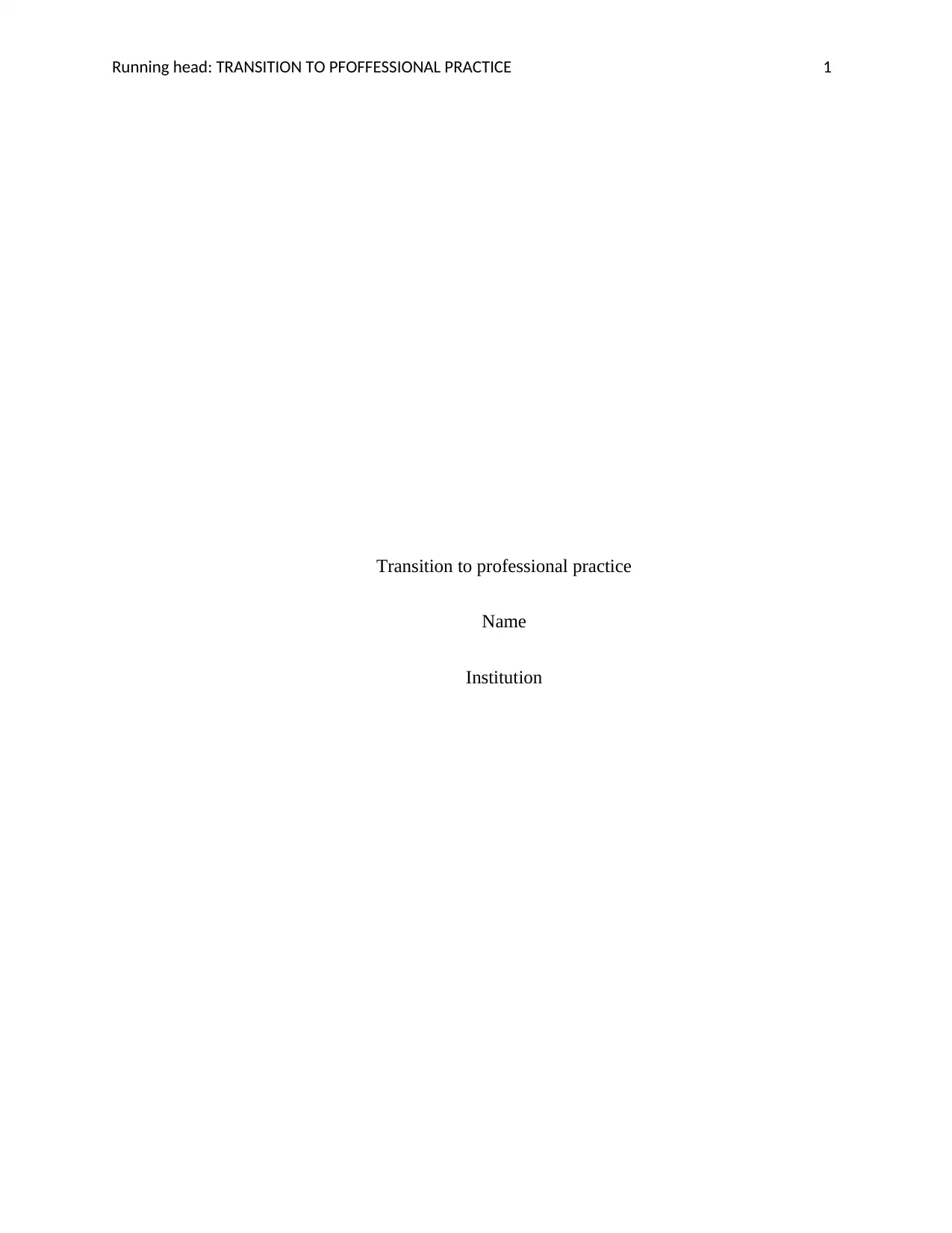
Running head: TRANSITION TO PFOFFESSIONAL PRACTICE 1
Transition to professional practice
Name
Institution
Transition to professional practice
Name
Institution
Paraphrase This Document
Need a fresh take? Get an instant paraphrase of this document with our AI Paraphraser
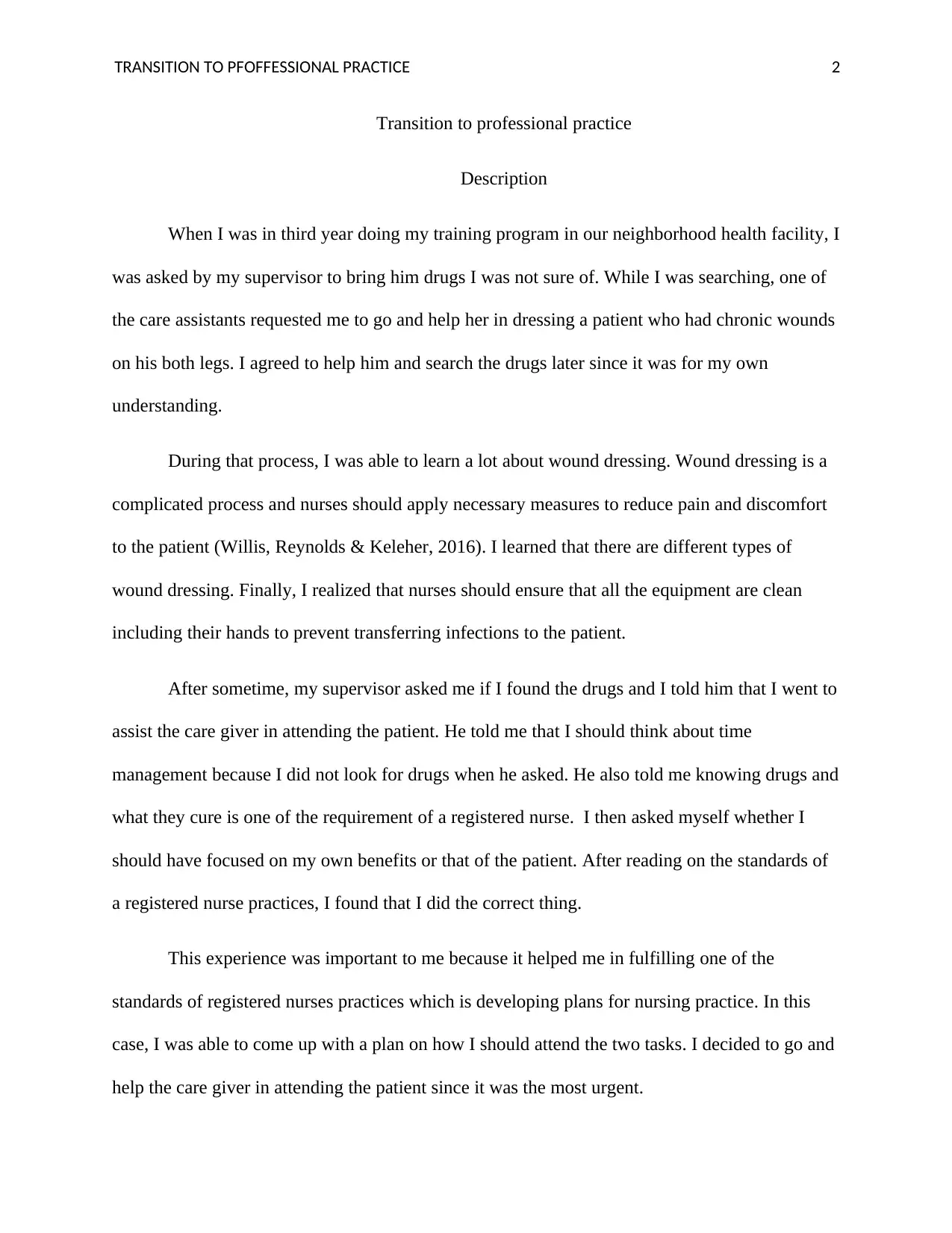
TRANSITION TO PFOFFESSIONAL PRACTICE 2
Transition to professional practice
Description
When I was in third year doing my training program in our neighborhood health facility, I
was asked by my supervisor to bring him drugs I was not sure of. While I was searching, one of
the care assistants requested me to go and help her in dressing a patient who had chronic wounds
on his both legs. I agreed to help him and search the drugs later since it was for my own
understanding.
During that process, I was able to learn a lot about wound dressing. Wound dressing is a
complicated process and nurses should apply necessary measures to reduce pain and discomfort
to the patient (Willis, Reynolds & Keleher, 2016). I learned that there are different types of
wound dressing. Finally, I realized that nurses should ensure that all the equipment are clean
including their hands to prevent transferring infections to the patient.
After sometime, my supervisor asked me if I found the drugs and I told him that I went to
assist the care giver in attending the patient. He told me that I should think about time
management because I did not look for drugs when he asked. He also told me knowing drugs and
what they cure is one of the requirement of a registered nurse. I then asked myself whether I
should have focused on my own benefits or that of the patient. After reading on the standards of
a registered nurse practices, I found that I did the correct thing.
This experience was important to me because it helped me in fulfilling one of the
standards of registered nurses practices which is developing plans for nursing practice. In this
case, I was able to come up with a plan on how I should attend the two tasks. I decided to go and
help the care giver in attending the patient since it was the most urgent.
Transition to professional practice
Description
When I was in third year doing my training program in our neighborhood health facility, I
was asked by my supervisor to bring him drugs I was not sure of. While I was searching, one of
the care assistants requested me to go and help her in dressing a patient who had chronic wounds
on his both legs. I agreed to help him and search the drugs later since it was for my own
understanding.
During that process, I was able to learn a lot about wound dressing. Wound dressing is a
complicated process and nurses should apply necessary measures to reduce pain and discomfort
to the patient (Willis, Reynolds & Keleher, 2016). I learned that there are different types of
wound dressing. Finally, I realized that nurses should ensure that all the equipment are clean
including their hands to prevent transferring infections to the patient.
After sometime, my supervisor asked me if I found the drugs and I told him that I went to
assist the care giver in attending the patient. He told me that I should think about time
management because I did not look for drugs when he asked. He also told me knowing drugs and
what they cure is one of the requirement of a registered nurse. I then asked myself whether I
should have focused on my own benefits or that of the patient. After reading on the standards of
a registered nurse practices, I found that I did the correct thing.
This experience was important to me because it helped me in fulfilling one of the
standards of registered nurses practices which is developing plans for nursing practice. In this
case, I was able to come up with a plan on how I should attend the two tasks. I decided to go and
help the care giver in attending the patient since it was the most urgent.
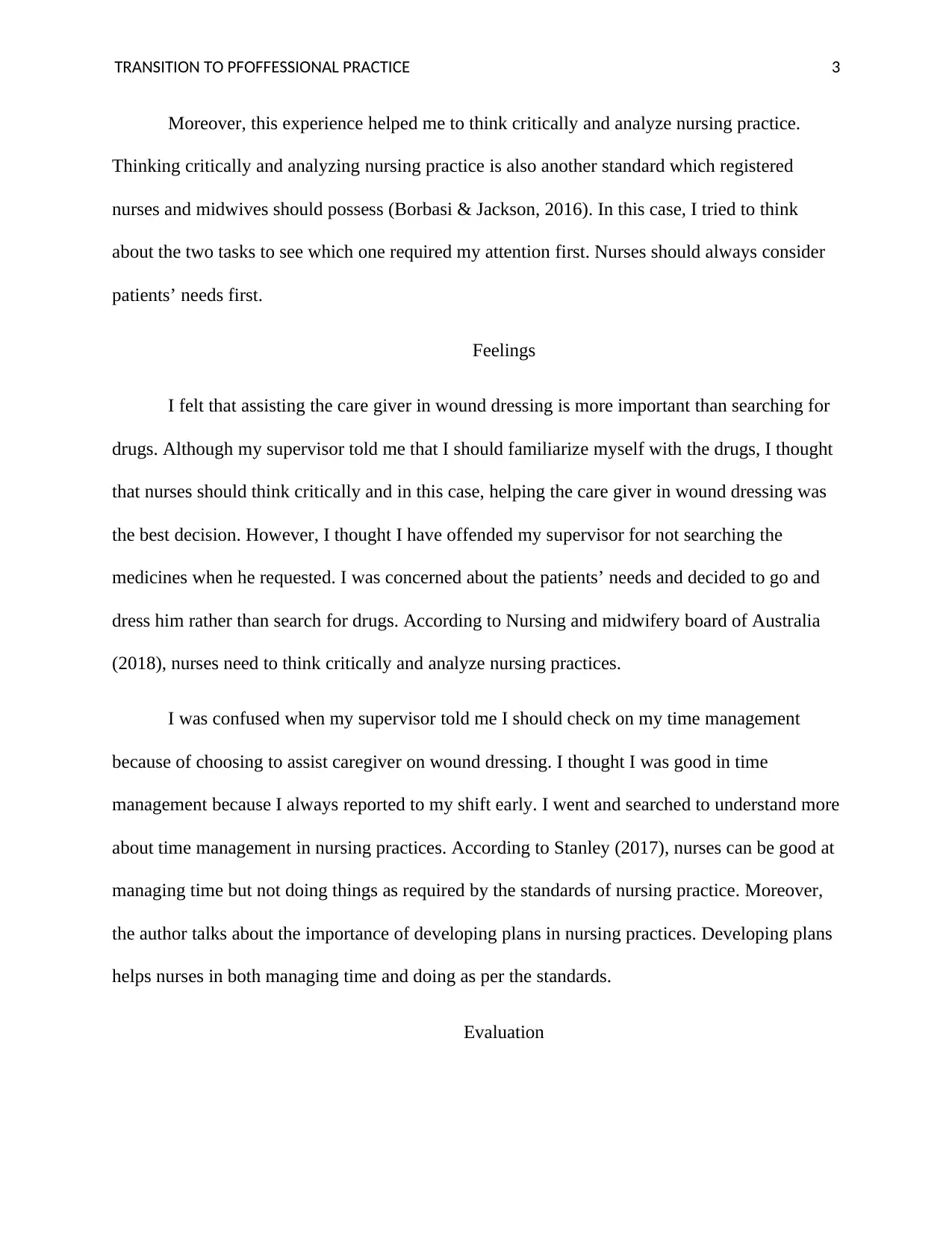
TRANSITION TO PFOFFESSIONAL PRACTICE 3
Moreover, this experience helped me to think critically and analyze nursing practice.
Thinking critically and analyzing nursing practice is also another standard which registered
nurses and midwives should possess (Borbasi & Jackson, 2016). In this case, I tried to think
about the two tasks to see which one required my attention first. Nurses should always consider
patients’ needs first.
Feelings
I felt that assisting the care giver in wound dressing is more important than searching for
drugs. Although my supervisor told me that I should familiarize myself with the drugs, I thought
that nurses should think critically and in this case, helping the care giver in wound dressing was
the best decision. However, I thought I have offended my supervisor for not searching the
medicines when he requested. I was concerned about the patients’ needs and decided to go and
dress him rather than search for drugs. According to Nursing and midwifery board of Australia
(2018), nurses need to think critically and analyze nursing practices.
I was confused when my supervisor told me I should check on my time management
because of choosing to assist caregiver on wound dressing. I thought I was good in time
management because I always reported to my shift early. I went and searched to understand more
about time management in nursing practices. According to Stanley (2017), nurses can be good at
managing time but not doing things as required by the standards of nursing practice. Moreover,
the author talks about the importance of developing plans in nursing practices. Developing plans
helps nurses in both managing time and doing as per the standards.
Evaluation
Moreover, this experience helped me to think critically and analyze nursing practice.
Thinking critically and analyzing nursing practice is also another standard which registered
nurses and midwives should possess (Borbasi & Jackson, 2016). In this case, I tried to think
about the two tasks to see which one required my attention first. Nurses should always consider
patients’ needs first.
Feelings
I felt that assisting the care giver in wound dressing is more important than searching for
drugs. Although my supervisor told me that I should familiarize myself with the drugs, I thought
that nurses should think critically and in this case, helping the care giver in wound dressing was
the best decision. However, I thought I have offended my supervisor for not searching the
medicines when he requested. I was concerned about the patients’ needs and decided to go and
dress him rather than search for drugs. According to Nursing and midwifery board of Australia
(2018), nurses need to think critically and analyze nursing practices.
I was confused when my supervisor told me I should check on my time management
because of choosing to assist caregiver on wound dressing. I thought I was good in time
management because I always reported to my shift early. I went and searched to understand more
about time management in nursing practices. According to Stanley (2017), nurses can be good at
managing time but not doing things as required by the standards of nursing practice. Moreover,
the author talks about the importance of developing plans in nursing practices. Developing plans
helps nurses in both managing time and doing as per the standards.
Evaluation
⊘ This is a preview!⊘
Do you want full access?
Subscribe today to unlock all pages.

Trusted by 1+ million students worldwide
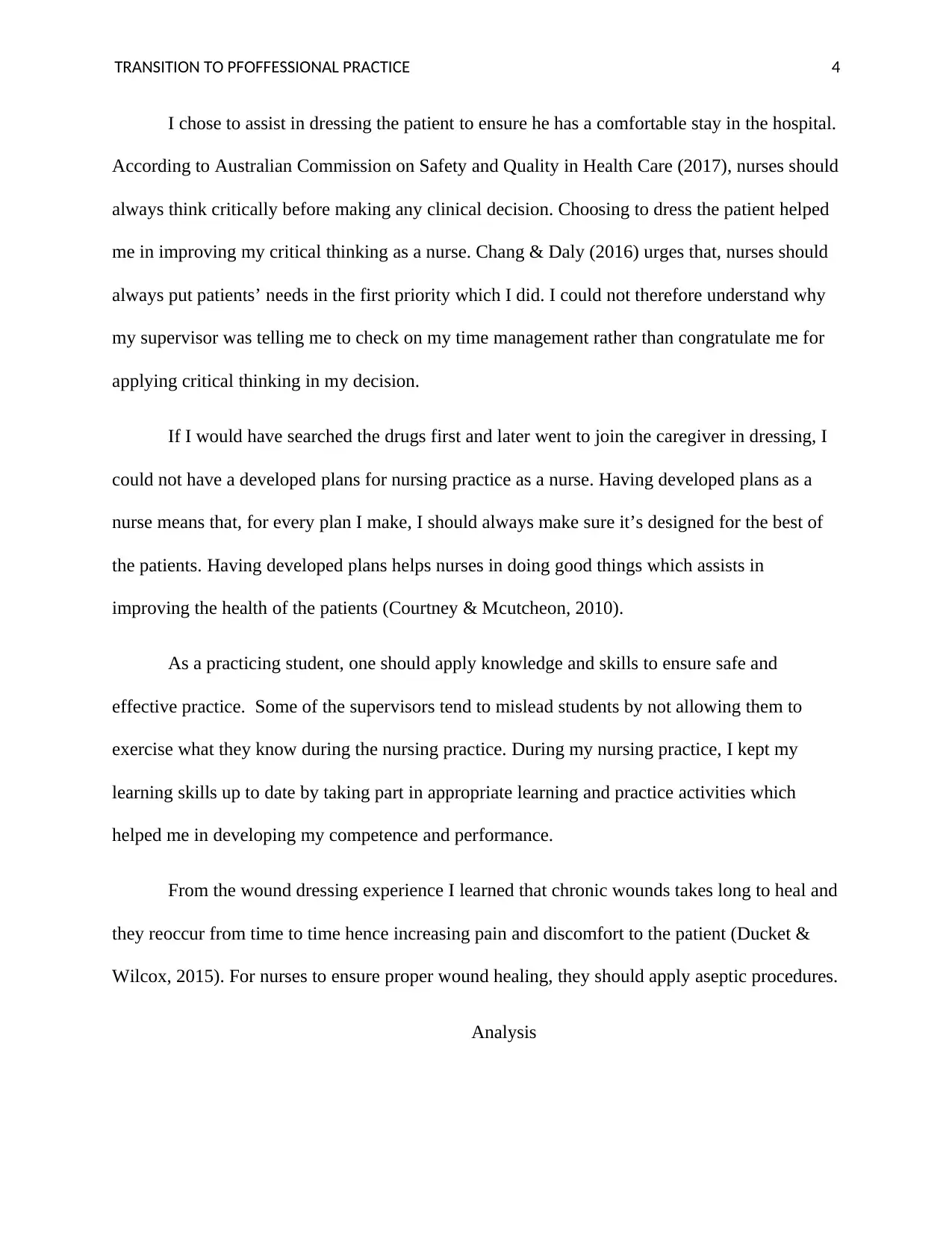
TRANSITION TO PFOFFESSIONAL PRACTICE 4
I chose to assist in dressing the patient to ensure he has a comfortable stay in the hospital.
According to Australian Commission on Safety and Quality in Health Care (2017), nurses should
always think critically before making any clinical decision. Choosing to dress the patient helped
me in improving my critical thinking as a nurse. Chang & Daly (2016) urges that, nurses should
always put patients’ needs in the first priority which I did. I could not therefore understand why
my supervisor was telling me to check on my time management rather than congratulate me for
applying critical thinking in my decision.
If I would have searched the drugs first and later went to join the caregiver in dressing, I
could not have a developed plans for nursing practice as a nurse. Having developed plans as a
nurse means that, for every plan I make, I should always make sure it’s designed for the best of
the patients. Having developed plans helps nurses in doing good things which assists in
improving the health of the patients (Courtney & Mcutcheon, 2010).
As a practicing student, one should apply knowledge and skills to ensure safe and
effective practice. Some of the supervisors tend to mislead students by not allowing them to
exercise what they know during the nursing practice. During my nursing practice, I kept my
learning skills up to date by taking part in appropriate learning and practice activities which
helped me in developing my competence and performance.
From the wound dressing experience I learned that chronic wounds takes long to heal and
they reoccur from time to time hence increasing pain and discomfort to the patient (Ducket &
Wilcox, 2015). For nurses to ensure proper wound healing, they should apply aseptic procedures.
Analysis
I chose to assist in dressing the patient to ensure he has a comfortable stay in the hospital.
According to Australian Commission on Safety and Quality in Health Care (2017), nurses should
always think critically before making any clinical decision. Choosing to dress the patient helped
me in improving my critical thinking as a nurse. Chang & Daly (2016) urges that, nurses should
always put patients’ needs in the first priority which I did. I could not therefore understand why
my supervisor was telling me to check on my time management rather than congratulate me for
applying critical thinking in my decision.
If I would have searched the drugs first and later went to join the caregiver in dressing, I
could not have a developed plans for nursing practice as a nurse. Having developed plans as a
nurse means that, for every plan I make, I should always make sure it’s designed for the best of
the patients. Having developed plans helps nurses in doing good things which assists in
improving the health of the patients (Courtney & Mcutcheon, 2010).
As a practicing student, one should apply knowledge and skills to ensure safe and
effective practice. Some of the supervisors tend to mislead students by not allowing them to
exercise what they know during the nursing practice. During my nursing practice, I kept my
learning skills up to date by taking part in appropriate learning and practice activities which
helped me in developing my competence and performance.
From the wound dressing experience I learned that chronic wounds takes long to heal and
they reoccur from time to time hence increasing pain and discomfort to the patient (Ducket &
Wilcox, 2015). For nurses to ensure proper wound healing, they should apply aseptic procedures.
Analysis
Paraphrase This Document
Need a fresh take? Get an instant paraphrase of this document with our AI Paraphraser
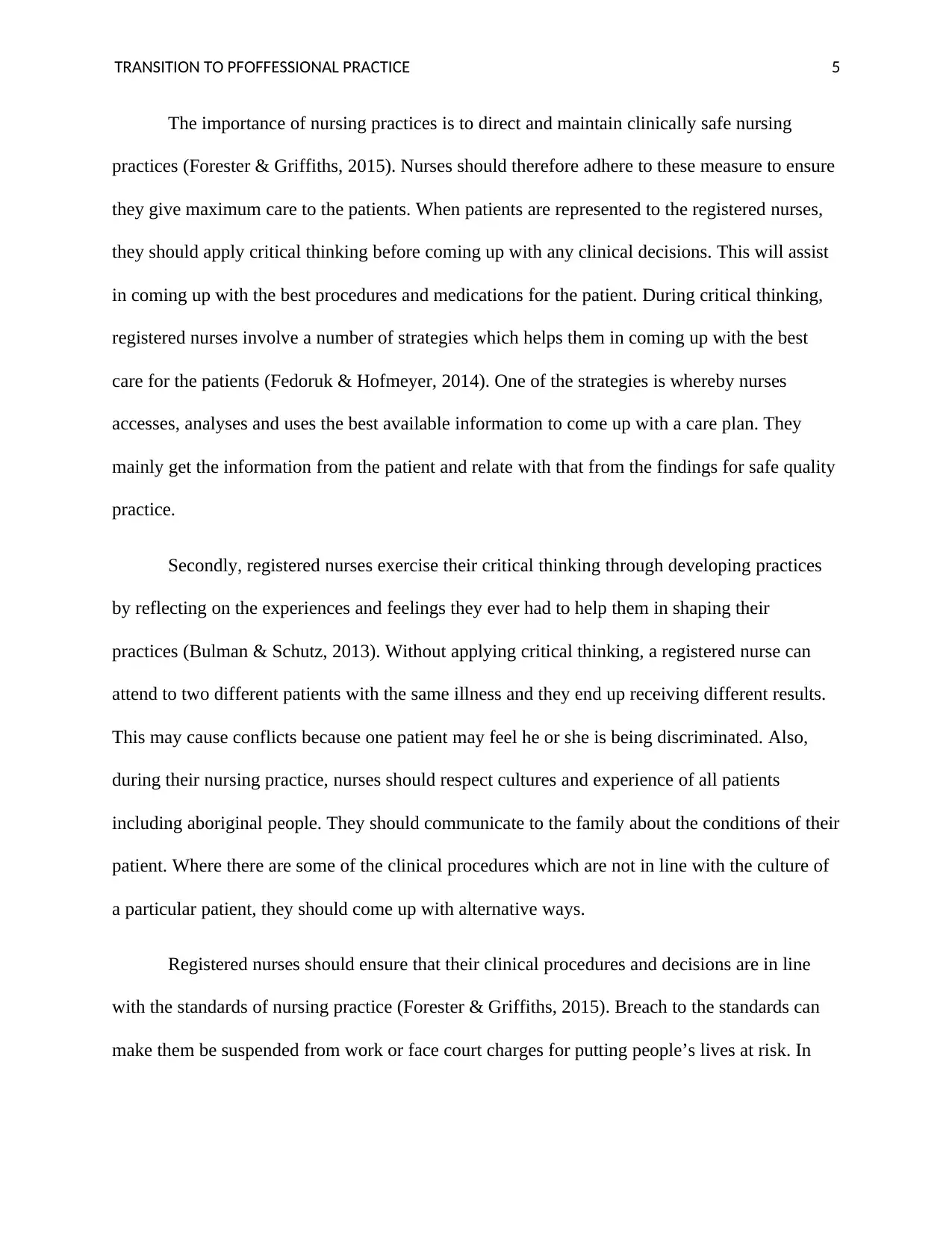
TRANSITION TO PFOFFESSIONAL PRACTICE 5
The importance of nursing practices is to direct and maintain clinically safe nursing
practices (Forester & Griffiths, 2015). Nurses should therefore adhere to these measure to ensure
they give maximum care to the patients. When patients are represented to the registered nurses,
they should apply critical thinking before coming up with any clinical decisions. This will assist
in coming up with the best procedures and medications for the patient. During critical thinking,
registered nurses involve a number of strategies which helps them in coming up with the best
care for the patients (Fedoruk & Hofmeyer, 2014). One of the strategies is whereby nurses
accesses, analyses and uses the best available information to come up with a care plan. They
mainly get the information from the patient and relate with that from the findings for safe quality
practice.
Secondly, registered nurses exercise their critical thinking through developing practices
by reflecting on the experiences and feelings they ever had to help them in shaping their
practices (Bulman & Schutz, 2013). Without applying critical thinking, a registered nurse can
attend to two different patients with the same illness and they end up receiving different results.
This may cause conflicts because one patient may feel he or she is being discriminated. Also,
during their nursing practice, nurses should respect cultures and experience of all patients
including aboriginal people. They should communicate to the family about the conditions of their
patient. Where there are some of the clinical procedures which are not in line with the culture of
a particular patient, they should come up with alternative ways.
Registered nurses should ensure that their clinical procedures and decisions are in line
with the standards of nursing practice (Forester & Griffiths, 2015). Breach to the standards can
make them be suspended from work or face court charges for putting people’s lives at risk. In
The importance of nursing practices is to direct and maintain clinically safe nursing
practices (Forester & Griffiths, 2015). Nurses should therefore adhere to these measure to ensure
they give maximum care to the patients. When patients are represented to the registered nurses,
they should apply critical thinking before coming up with any clinical decisions. This will assist
in coming up with the best procedures and medications for the patient. During critical thinking,
registered nurses involve a number of strategies which helps them in coming up with the best
care for the patients (Fedoruk & Hofmeyer, 2014). One of the strategies is whereby nurses
accesses, analyses and uses the best available information to come up with a care plan. They
mainly get the information from the patient and relate with that from the findings for safe quality
practice.
Secondly, registered nurses exercise their critical thinking through developing practices
by reflecting on the experiences and feelings they ever had to help them in shaping their
practices (Bulman & Schutz, 2013). Without applying critical thinking, a registered nurse can
attend to two different patients with the same illness and they end up receiving different results.
This may cause conflicts because one patient may feel he or she is being discriminated. Also,
during their nursing practice, nurses should respect cultures and experience of all patients
including aboriginal people. They should communicate to the family about the conditions of their
patient. Where there are some of the clinical procedures which are not in line with the culture of
a particular patient, they should come up with alternative ways.
Registered nurses should ensure that their clinical procedures and decisions are in line
with the standards of nursing practice (Forester & Griffiths, 2015). Breach to the standards can
make them be suspended from work or face court charges for putting people’s lives at risk. In
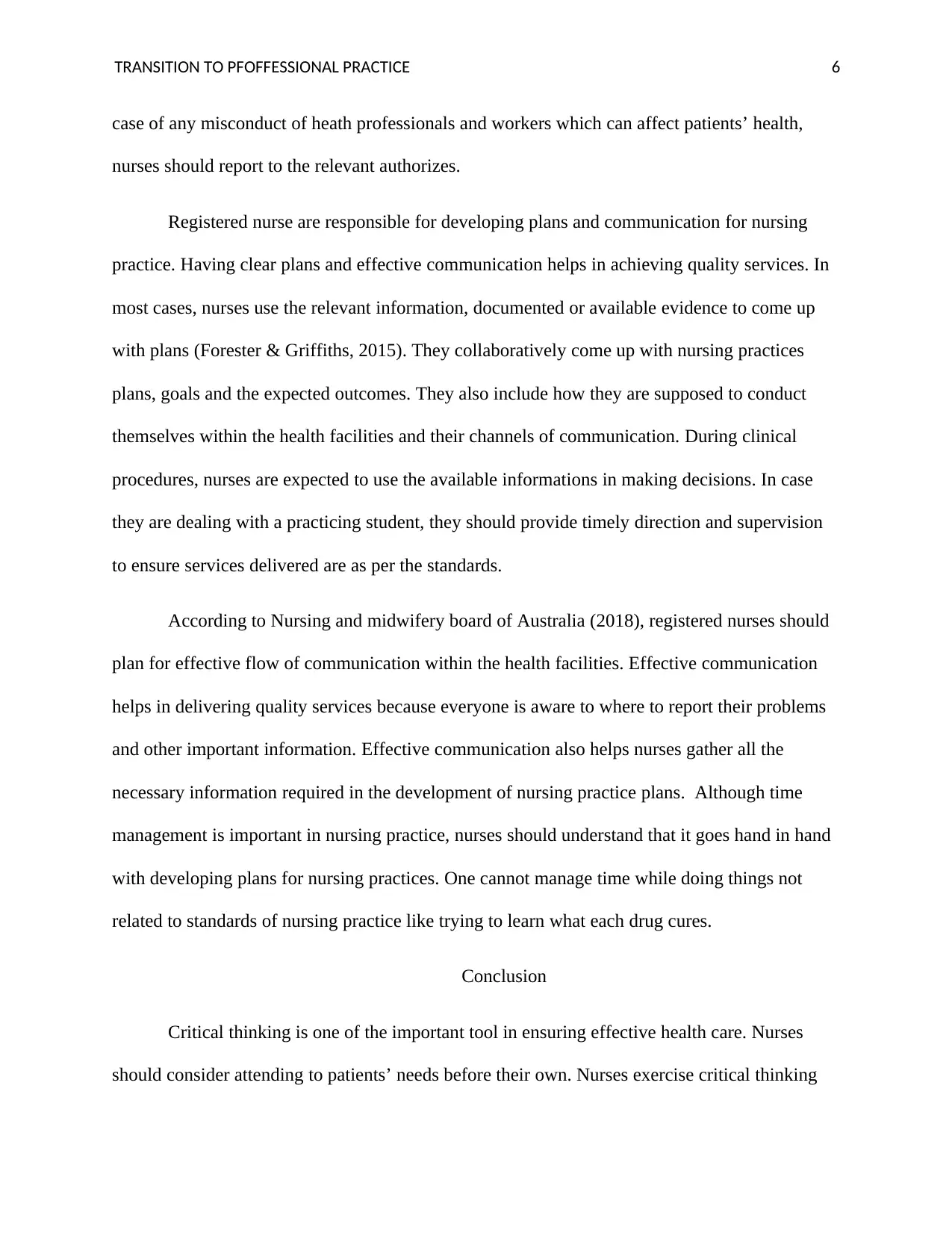
TRANSITION TO PFOFFESSIONAL PRACTICE 6
case of any misconduct of heath professionals and workers which can affect patients’ health,
nurses should report to the relevant authorizes.
Registered nurse are responsible for developing plans and communication for nursing
practice. Having clear plans and effective communication helps in achieving quality services. In
most cases, nurses use the relevant information, documented or available evidence to come up
with plans (Forester & Griffiths, 2015). They collaboratively come up with nursing practices
plans, goals and the expected outcomes. They also include how they are supposed to conduct
themselves within the health facilities and their channels of communication. During clinical
procedures, nurses are expected to use the available informations in making decisions. In case
they are dealing with a practicing student, they should provide timely direction and supervision
to ensure services delivered are as per the standards.
According to Nursing and midwifery board of Australia (2018), registered nurses should
plan for effective flow of communication within the health facilities. Effective communication
helps in delivering quality services because everyone is aware to where to report their problems
and other important information. Effective communication also helps nurses gather all the
necessary information required in the development of nursing practice plans. Although time
management is important in nursing practice, nurses should understand that it goes hand in hand
with developing plans for nursing practices. One cannot manage time while doing things not
related to standards of nursing practice like trying to learn what each drug cures.
Conclusion
Critical thinking is one of the important tool in ensuring effective health care. Nurses
should consider attending to patients’ needs before their own. Nurses exercise critical thinking
case of any misconduct of heath professionals and workers which can affect patients’ health,
nurses should report to the relevant authorizes.
Registered nurse are responsible for developing plans and communication for nursing
practice. Having clear plans and effective communication helps in achieving quality services. In
most cases, nurses use the relevant information, documented or available evidence to come up
with plans (Forester & Griffiths, 2015). They collaboratively come up with nursing practices
plans, goals and the expected outcomes. They also include how they are supposed to conduct
themselves within the health facilities and their channels of communication. During clinical
procedures, nurses are expected to use the available informations in making decisions. In case
they are dealing with a practicing student, they should provide timely direction and supervision
to ensure services delivered are as per the standards.
According to Nursing and midwifery board of Australia (2018), registered nurses should
plan for effective flow of communication within the health facilities. Effective communication
helps in delivering quality services because everyone is aware to where to report their problems
and other important information. Effective communication also helps nurses gather all the
necessary information required in the development of nursing practice plans. Although time
management is important in nursing practice, nurses should understand that it goes hand in hand
with developing plans for nursing practices. One cannot manage time while doing things not
related to standards of nursing practice like trying to learn what each drug cures.
Conclusion
Critical thinking is one of the important tool in ensuring effective health care. Nurses
should consider attending to patients’ needs before their own. Nurses exercise critical thinking
⊘ This is a preview!⊘
Do you want full access?
Subscribe today to unlock all pages.

Trusted by 1+ million students worldwide
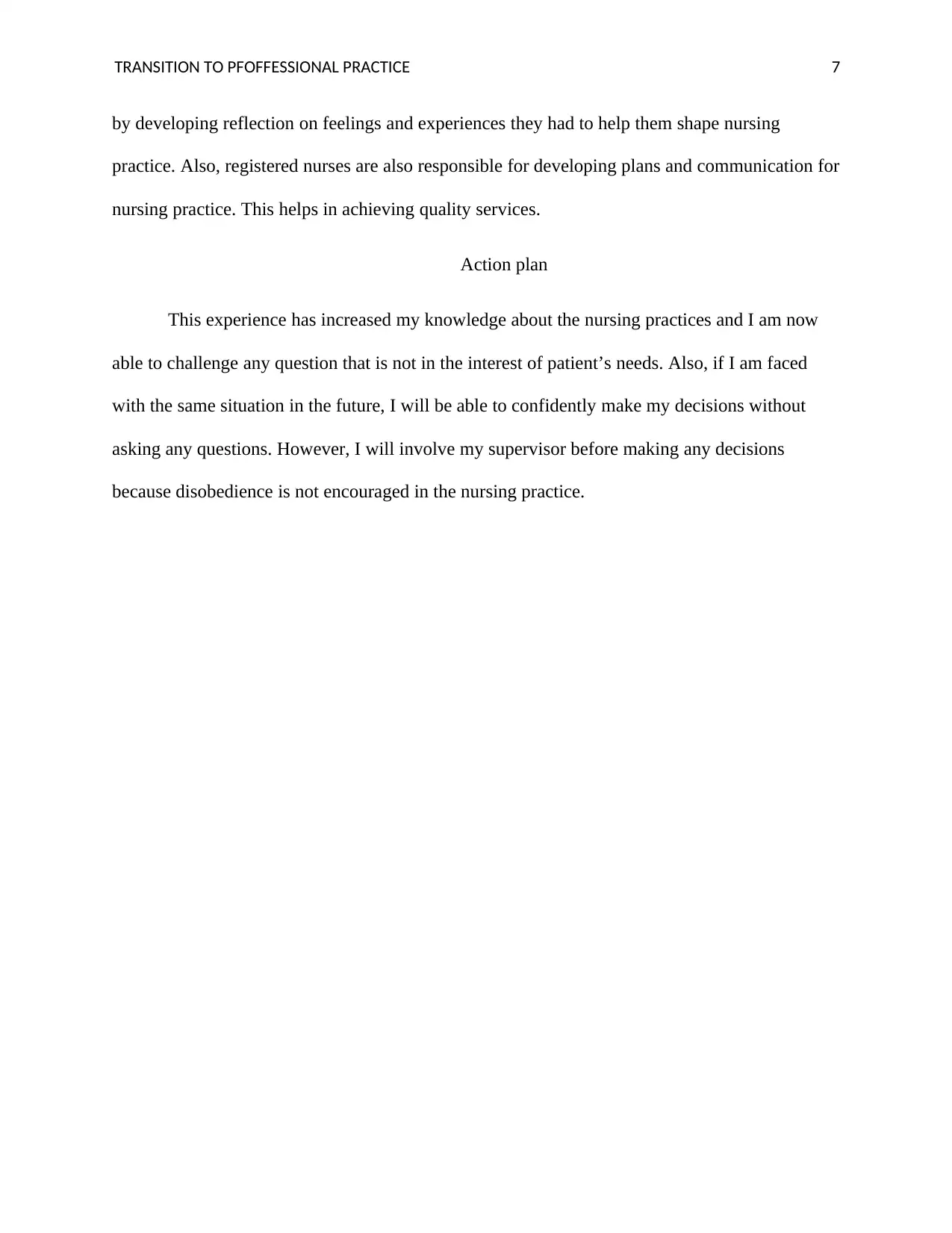
TRANSITION TO PFOFFESSIONAL PRACTICE 7
by developing reflection on feelings and experiences they had to help them shape nursing
practice. Also, registered nurses are also responsible for developing plans and communication for
nursing practice. This helps in achieving quality services.
Action plan
This experience has increased my knowledge about the nursing practices and I am now
able to challenge any question that is not in the interest of patient’s needs. Also, if I am faced
with the same situation in the future, I will be able to confidently make my decisions without
asking any questions. However, I will involve my supervisor before making any decisions
because disobedience is not encouraged in the nursing practice.
by developing reflection on feelings and experiences they had to help them shape nursing
practice. Also, registered nurses are also responsible for developing plans and communication for
nursing practice. This helps in achieving quality services.
Action plan
This experience has increased my knowledge about the nursing practices and I am now
able to challenge any question that is not in the interest of patient’s needs. Also, if I am faced
with the same situation in the future, I will be able to confidently make my decisions without
asking any questions. However, I will involve my supervisor before making any decisions
because disobedience is not encouraged in the nursing practice.
Paraphrase This Document
Need a fresh take? Get an instant paraphrase of this document with our AI Paraphraser
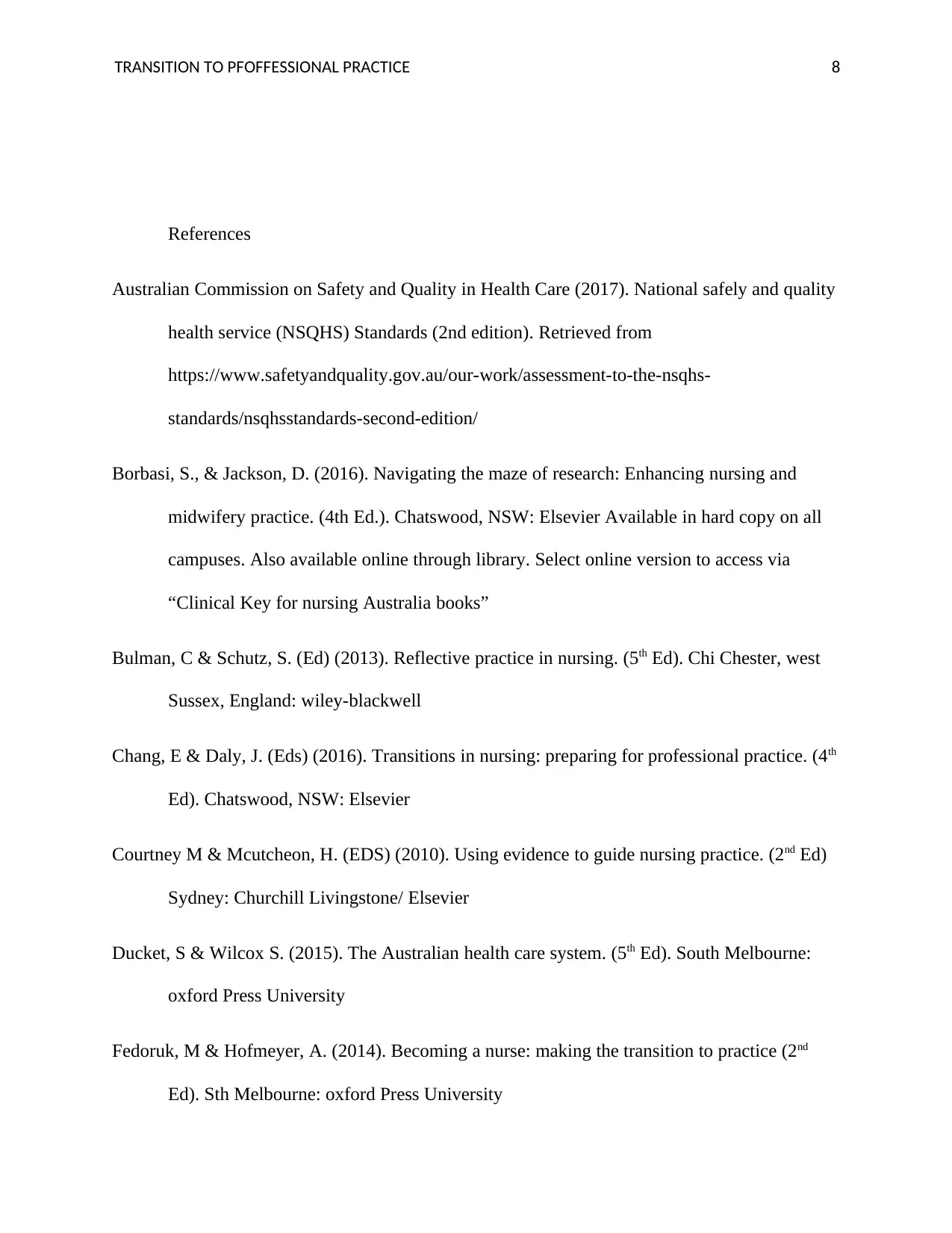
TRANSITION TO PFOFFESSIONAL PRACTICE 8
References
Australian Commission on Safety and Quality in Health Care (2017). National safely and quality
health service (NSQHS) Standards (2nd edition). Retrieved from
https://www.safetyandquality.gov.au/our-work/assessment-to-the-nsqhs-
standards/nsqhsstandards-second-edition/
Borbasi, S., & Jackson, D. (2016). Navigating the maze of research: Enhancing nursing and
midwifery practice. (4th Ed.). Chatswood, NSW: Elsevier Available in hard copy on all
campuses. Also available online through library. Select online version to access via
“Clinical Key for nursing Australia books”
Bulman, C & Schutz, S. (Ed) (2013). Reflective practice in nursing. (5th Ed). Chi Chester, west
Sussex, England: wiley-blackwell
Chang, E & Daly, J. (Eds) (2016). Transitions in nursing: preparing for professional practice. (4th
Ed). Chatswood, NSW: Elsevier
Courtney M & Mcutcheon, H. (EDS) (2010). Using evidence to guide nursing practice. (2nd Ed)
Sydney: Churchill Livingstone/ Elsevier
Ducket, S & Wilcox S. (2015). The Australian health care system. (5th Ed). South Melbourne:
oxford Press University
Fedoruk, M & Hofmeyer, A. (2014). Becoming a nurse: making the transition to practice (2nd
Ed). Sth Melbourne: oxford Press University
References
Australian Commission on Safety and Quality in Health Care (2017). National safely and quality
health service (NSQHS) Standards (2nd edition). Retrieved from
https://www.safetyandquality.gov.au/our-work/assessment-to-the-nsqhs-
standards/nsqhsstandards-second-edition/
Borbasi, S., & Jackson, D. (2016). Navigating the maze of research: Enhancing nursing and
midwifery practice. (4th Ed.). Chatswood, NSW: Elsevier Available in hard copy on all
campuses. Also available online through library. Select online version to access via
“Clinical Key for nursing Australia books”
Bulman, C & Schutz, S. (Ed) (2013). Reflective practice in nursing. (5th Ed). Chi Chester, west
Sussex, England: wiley-blackwell
Chang, E & Daly, J. (Eds) (2016). Transitions in nursing: preparing for professional practice. (4th
Ed). Chatswood, NSW: Elsevier
Courtney M & Mcutcheon, H. (EDS) (2010). Using evidence to guide nursing practice. (2nd Ed)
Sydney: Churchill Livingstone/ Elsevier
Ducket, S & Wilcox S. (2015). The Australian health care system. (5th Ed). South Melbourne:
oxford Press University
Fedoruk, M & Hofmeyer, A. (2014). Becoming a nurse: making the transition to practice (2nd
Ed). Sth Melbourne: oxford Press University
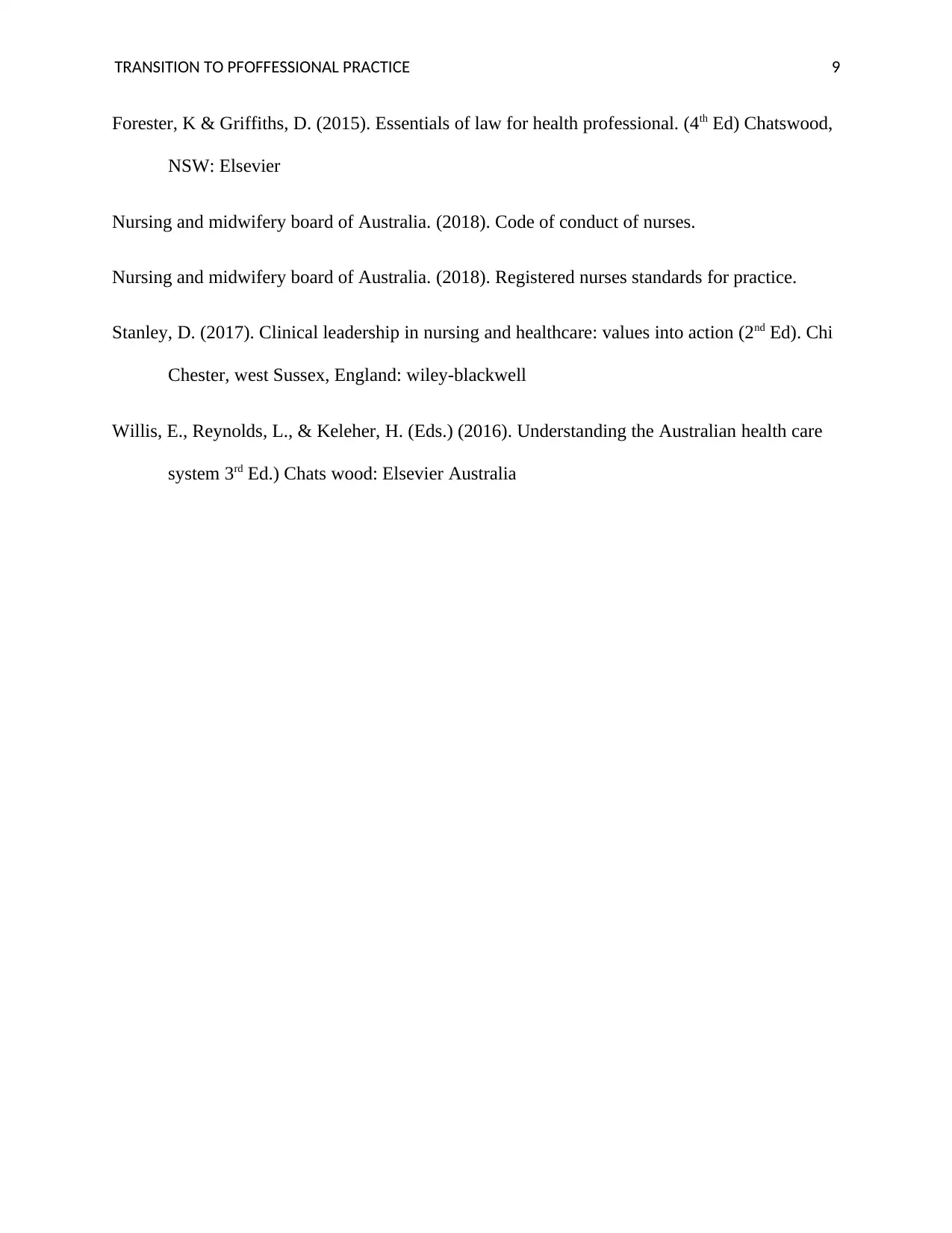
TRANSITION TO PFOFFESSIONAL PRACTICE 9
Forester, K & Griffiths, D. (2015). Essentials of law for health professional. (4th Ed) Chatswood,
NSW: Elsevier
Nursing and midwifery board of Australia. (2018). Code of conduct of nurses.
Nursing and midwifery board of Australia. (2018). Registered nurses standards for practice.
Stanley, D. (2017). Clinical leadership in nursing and healthcare: values into action (2nd Ed). Chi
Chester, west Sussex, England: wiley-blackwell
Willis, E., Reynolds, L., & Keleher, H. (Eds.) (2016). Understanding the Australian health care
system 3rd Ed.) Chats wood: Elsevier Australia
Forester, K & Griffiths, D. (2015). Essentials of law for health professional. (4th Ed) Chatswood,
NSW: Elsevier
Nursing and midwifery board of Australia. (2018). Code of conduct of nurses.
Nursing and midwifery board of Australia. (2018). Registered nurses standards for practice.
Stanley, D. (2017). Clinical leadership in nursing and healthcare: values into action (2nd Ed). Chi
Chester, west Sussex, England: wiley-blackwell
Willis, E., Reynolds, L., & Keleher, H. (Eds.) (2016). Understanding the Australian health care
system 3rd Ed.) Chats wood: Elsevier Australia
⊘ This is a preview!⊘
Do you want full access?
Subscribe today to unlock all pages.

Trusted by 1+ million students worldwide
1 out of 9
Related Documents
Your All-in-One AI-Powered Toolkit for Academic Success.
+13062052269
info@desklib.com
Available 24*7 on WhatsApp / Email
![[object Object]](/_next/static/media/star-bottom.7253800d.svg)
Unlock your academic potential
Copyright © 2020–2025 A2Z Services. All Rights Reserved. Developed and managed by ZUCOL.




